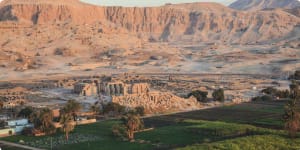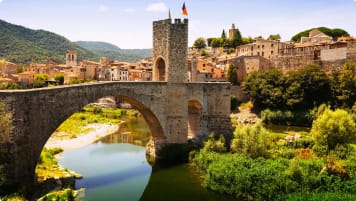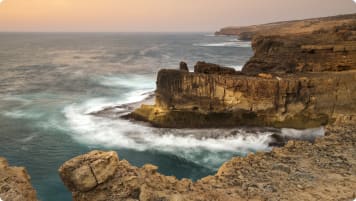Egypt tour: escorted small group history & cultural tour of Egypt
Our small-group program, designed for senior couples and solo travellers, offers a rich journey through Egypt's past and present. You'll explore modern marvels like the Aswan Dam and immerse yourself in pivotal sites such as Tahrir Square, both key to understanding Egypt’s enduring influence on civilization. This tour is proof that Egypt remains a vital crossroads of history and culture. We explore Egypt's fairy-tale natural beauty, its ancient history, and Imperial heritage, its World Heritage Sites, and world famous cities, all with some truly spectacular scenery along the way. For those seeking an even deeper experience, we also offer opportunities to extend your travels with our tours in Morocco, Jordan, or Tunisia before beginning your Egyptian adventure.
From $14,563NZD
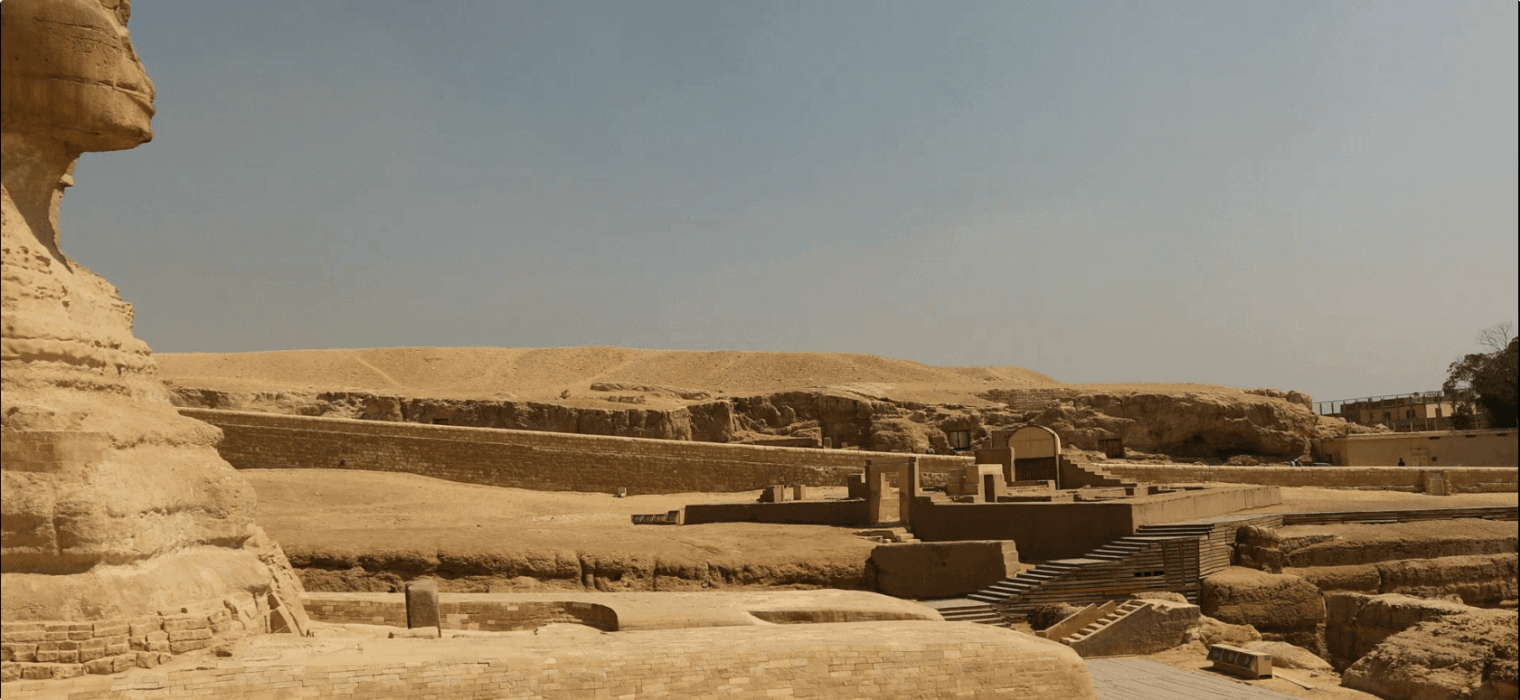
Highlights
- 1. See the Oasis of Wadi El Sebou and Alexandria.
- 2. Cruise down the Nile River and enjoy shore excursions to Luxor, the Valley of Kings, and Kom Ombo.
- 3. Experience the Red Pyramid, the Great Pyramids, the Valley Temple, and the Sphinx.
- 4. Visit the Temple of Philae, the 3000 year old Abu Simbel, and Lake Nasser.

Departure Dates
| Departure Date | Price |
|---|---|
| 03 November 2025 Ends 20 November 2025 • 18 days $14,563 Twin $18,895 Single Pre-guaranteed | |
| 19 January 2026 Ends 05 February 2026 • 18 days $14,563 Twin $18,895 Single Guaranteed | Selected |
| 02 November 2026 Ends 19 November 2026 • 18 days $14,563 Twin $18,895 Single Available |
Ancient History of Egypt escorted Small Group tour
We explore Egypt's fairy-tale natural beauty, its ancient history, and Imperial heritage, its World Heritage Sites, and world famous cities, all with some truly spectacular scenery along the way. This and more is all waiting to be explored on one of Odyssey’s small group tours of Egypt, designed for the senior traveller, and led by experienced, and enthusiastic like minded people.
Visit Egypt with Odyssey Traveller on these escorted tours as we stand in awe of the symmetry and majesty of the Egyptians’ ancient pyramids from Luxor to Aswan, and discuss the country's present-day experiences and accomplishments.
Ancient Egypt, An Advanced Civilisation
Egypt is located in the northeast corner of the African continent and has two coastlines–the Mediterranean coastline in the north and the longer Red Sea and Gulf of Aqaba coastline in the east. The river Nile flowing in its heartland is the longest river in Africa.
A settlement that would later become Egypt emerged from the fertile and life-giving Nile valley and delta about 5,000 years ago, and for 30 centuries it was the principal civilisation in the ancient Mediterranean. Ancient Egypt’s history, language, religion, and architecture continue to capture the imagination of archaeologists and historians, and has given rise to a specific field of study called “Egyptology”.
Modern historians say ancient Egypt had 31 dynasties (with the rulers later called pharaohs, from per aa, “great house” or “great estate”), and these dynasties were divided into several periods or kingdoms. The legendary king Menes was said to be the first ruler of the first dynasty, but there had been rulers before him, lost now to history.
The pyramids of Giza were built during the age of the Old Kingdom (circa 2650–2150 BC). An ancient Egyptian medical text, the Edwin Smith Surgical Papyrus, is considered the oldest known surgical treatise and dates back to the Middle Kingdom (circa 2030–1640 BC)–one of the many testaments to ancient Egypt’s advanced civilisation.
Small group tours Egypt itinerary
This Ancient History of Egypt journey includes a day tour in Cairo. In the Egyptian capital, we visit the Mohammad Ali Alabaster Mosque in the Citadel. The Mosque was constructed from 1830 to 1857 under Mohammed Ali Pasha in the Ottoman style. Mohammed Ali Pasha was the ruler of Egypt and the founder of the country's last dynasty. Next, we drive to timeless Old Cairo, a UNESCO World Heritage Site. During the journey, we will visit the Old Coptic Church and the Hanging Church, deriving its name from the way its nave overhangs an historic passage. After visiting the Ben Ezra Synagogue, we explore the Egyptian Museum of Antiquities. The museum in Cairo houses the treasures of the Tomb of Tutankhamen, among other fascinating exhibits including the role of Linen. Time permitting the group explores the new Egyptian capital city as yet un-named and the administrative capital for Egypt.
On the next day of this tour, a qualified Egyptologist provides a walking tour of the Great Pyramids. We stop to see features such as a royal burial chamber, the Valley Temple, and the Sphinx. Because no image is more prized than that of the traveller riding a camel at Giza, we have arranged for members of our party to enjoy a short camel ride against the backdrop of the Pyramids. For the remainder of the tour, we explore the Egypt that is beyond Cairo. We travel south down to Luxor to Aswan on the way, and to Abu Simbel before making our way back to the capital.
The highlights of Egypt experienced in a small group tour
Other highlights of our private guided tours include visiting the Egyptian Museum, fully escorted by a qualified Egyptologist, and seeing the Oasis of Wadi El Seboua and Alexandria. We also enjoy a cruise down the spectacular Nile River and enjoy shore excursions to Luxor, the Valley of Kings, exploring there tombs with local guides and visit the double temple of Kom Ombo just outside Aswan. You will have the opportunity to take in the sights and learn about the Red Pyramid, the Great Pyramids, the Valley Temple, and the Sphinx and so much more. We also visit the Temple of Philae, the 3000-year-old Abu Simbel, and Lake Nasser.
Ancient History of Egypt escorted Small Groups for mature travellers engages with the best available Egyptologists and professional guides. While accompanying the tour, they share the archaeology, the history, and the state of contemporary Egypt. The tour is suited for the senior or mature-aged couple or solo travellers.
Articles published by Odyssey Traveller about Egypt.
The following articles may also be of interest:
- From Cairo to NAC: Egypt builds a new capital city
- Discover Egypt with 10 great books
- Egyptian Linen Treasures
- Top 20 World Heritage Sites You Must Visit
To view the page with all the articles published that are are relevant or about Egypt follow this link.
Links to External Sites About Egypt.
Learn more about Egypt before you travel with these articles and links to external sites.
- Egypt the country.A country profile from Odyssey.
- More small group tours to Africa
- Mesopotamia - HISTORY
- Ancient Near East and Egyptian | Penn History of Art
For more details, click the ‘Top 5’ or ‘Itinerary’ buttons above! If you’re keen to experience this tour, please call or send an email. Or, to book, simply fill in the form on the right hand side of this page.
Gallery

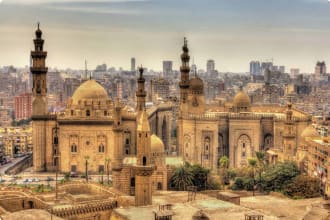
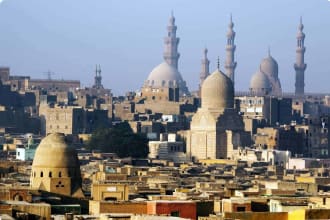
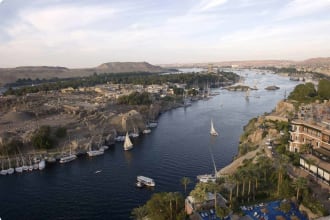
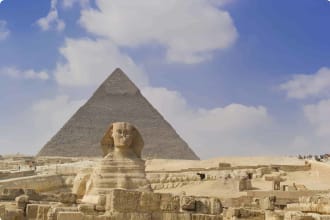

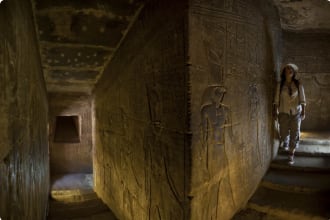
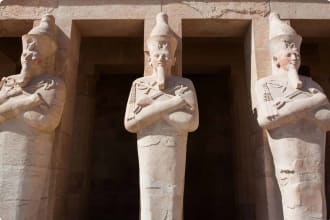

Itinerary
18 days
Day 1: Cairo
Accommodation: Fairmont Nile City or similar
Upon arrival in Cairo, we come to the hotel individually. Tonight, we enjoy a group dinner and program orientation.
(D)
Day 2: Cairo
Accommodation: Fairmont Nile City or similar
After breakfast, we drive to the grand Egyptian museum (GEM) to visit the Grand staircase gallery & attend King Tut Show.
Lunch will be served at a local restaurant.
After lunch transfer to visit the Egyptian Museum of Antiquities. Among other fascinating exhibits, see the treasures of the Tomb of Tutankhamen. In the late afternoon we will spend some time wandering the streets of Khan El Khalili bazaar.
(B,L)
Day 3: Cairo
Accommodation: Fairmont Nile City or similar
After breakfast we drive to the National Museum of Egyptian Civilization (NMEC), where you will have a private tour. You will see one of the most important and largest antiquities museums in the world. It is the first museum to be dedicated to the entirety of Egyptian civilization, where more than 50,000 artifacts will relate to the stages of the development of civilization, from the earliest times to the modern era. The museum’s holdings will be displayed in a permanent major exhibition that deals with the most important achievements of Egyptian civilization. The museum includes spaces for temporary exhibitions, research center for the science of ancient materials and restoration as well as the royal mummies gallery.
Afterwards, in the same area, we will explore the Old Cairo and walk back in time. We will visit the Old Coptic Church, the hanging Church and the Ben Ezra Synagogue. Lunch will be served at local restaurant. After lunch, we will continue to the Mohamad Ali Mosque (known as the Alabaster Mosque, situated in the Citadel of Salah El Din).
(B, L)
Day 4: Cairo
Accommodation: Fairmont Nile City or similar
This morning, our guide – a qualified Egyptologist – picks us up for a full day of sightseeing. We make our way to the Sakkara section of Memphis and the Step Pyramid, built for the 3rd Dynasty Pharaoh Djoser to hold his mummified body. Pharaoh Djoser’s Step Pyramid began as a traditional, flat-roofed mausoleum, but by the end of his 19-year reign, it had risen to 6 stepped layers and stood 204 feet (62 metres) high, making it the largest building of its time worldwide. We then visit a carpet school where young apprentices weave carpets manually with the same techniques that have been used since ancient times.
After lunch at a local restaurant, we drive 20 kilometres south of Cairo to see the Great Pyramids, a royal burial chamber, the Valley Temple, and the Sphinx. In the history of photography and travel, no image is more prized than that of the traveller riding a camel at Giza, so we have arranged for members of our party to enjoy a short camel ride with the Pyramids as the backdrop. We will return to the hotel to end our day.
(B,L)
Day 5: Luxor
Accommodation: 03 nights at Sonesta St. George Hotel or similar
This morning is free to explore the city of Cairo at our own pace.
In the afternoon, we transfer to Cairo Domestic Airport for our hour-long flight to Luxor. Upon arrival, we transfer to our hotel for check-in. In the evening, we visit the graceful Temple of Luxor built by Amenhotep III and Rameses II for rituals and festivals and dedicated to the god Amun. In the Egyptian language, the Temple is known as ipet resyt, “the southern sanctuary”. In Luxor there are several great temples on the east and west banks. Four of the major mortuary temples visited by early travelers and tourists include the Temple of Seti I at Gurnah, the Temple of Hatshepsut at Deir el Bahri, the Temple of Ramesses II (a.k.a. Ramesseum), and the Temple of Ramesses III at Medinet Habu; and the two primary cults temples on the east bank are known as the Karnak and Luxor. Unlike the other temples in Thebes, Luxor temple is not dedicated to a cult god or a deified version of the king in death. Instead Luxor temple is dedicated to the rejuvenation of kingship; it may have been where many of the kings of Egypt were crowned in reality or conceptually (as in the case of Alexander the Great who claimed he was crowned at Luxor but may never have traveled south of Memphis, near modern Cairo.)
(B,D)
Day 6: Luxor
Accommodation: Sonesta St. George Hotel or similar
This morning, we drive to the West Bank of the Nile and visit the wondrous Valley of the Kings, a vast city of the dead where the magnificent tombs of 62 pharaohs have been discovered. The tombs were carved deep into the desert rock, richly decorated, and filled with treasures for the afterlife of the pharaohs. We visit several of the key tombs of the Pharaohs including Ramose tomb, Deir el Medina, and the Valley of the Nobles. A highlight of this day in the Valley of the Kings is a visit to the Tomb of Tutankhamun. The group Located in the Theban Necropolis, these are the burial places of some of the powerful courtiers and persons of the ancient city. We end our tour with a boat transfer back to the East bank of the Nile and then transfer to our hotel for dinner.
(B,L,D)
Day 7: Luxor
Accommodation: Sonesta St. George Hotel or similar
Our day starts with an early breakfast so we make our way to visit Karnak Temple at sunrise, also known as “the Temple of Temples.” It is the largest place of worship ever built. Its ancient name Ipet-isut means “the most sacred of places.” The temple, or, more correctly, the complex of temples, was built more than 2,000 years ago under generations of Pharaohs. One spectacular feature within the temple is the great “Hypostyle Hall,” an incredible forest of giant pillars covering an area larger than the whole of Notre Dame Cathedral. Afterwards we will visit the Luxor Museum.
After lunch, we cross to the West Bank and visit the Temple of Queen Hatshepsut. This beautiful monument rises out of the desert plain in a series of terraces and merges with the sheer limestone cliffs that surround it. On the way back to our hotel, we stop at the famed Colossi of Memnon, two statues of Amenhotep III measuring 66 feet and weighing 1,000 tonnes. These colossal statues were known by the ancient Greeks to emit haunting voices at dawn. Though damaged by nature and ancient tourists, the statues are still impressive. Later on, we visit the Souk (market) of Luxor and return to our hotel.
(B,L,D)
Day 8: Nile Cruise
Accommodation: 04 nights aboard Nile Cruise MS Tulip or similar
After breakfast, we travel from Luxor by coach to Denderah, a distance of around 52 kilometres. Here we visit the Ptolomaic temple of the goddess Hathor. This incredible temple features a round ceiling covered in astronomical representations of the zodiac constellations. The temple was buried in sand up until the mid 1800s, when it was recovered. Two Roman fountains flank the path leading to the temple’s massive entry gate. The catacombs that run under the temple contain particularly enigmatic hieroglyphs and inscriptions. A packed lunch will be serven en route and later in the afternoon we board our cruise today to sail for to Aswan.
(B,L,D)
Day 9: Nile Cruise
Accommodation: MS Tulip or similar.
After breakfast, we visit the Museum of Mummification. In the era of the Pharaohs, it was believed that Pharaohs’ corpses needed proper care so that they would be able to carry out their new duties as king of the dead. If a kingly corpse was not properly preserved, it was believed that the royal cycle would be broken and disaster would befall Egypt. To prevent such a catastrophe, each dead Pharaoh was mummified to preserve his body. Everything the king would need in his afterlif,e such as furniture, food, and doll-like representations of servants was provided in their tombs in grave vessels made of clay, stone, and gold, so that his body would continue to receive food offerings long after his death. After our visit to the Museum of Mummification, we eat lunch on board the cruise while we sail to Esna.
(B,L,D)
Day 10: Nile Cruise
Accommodation: MS Tulip or similar.
After breakfast on board the boat, we set out by horse-drawn carriage to visit the Temple of Horus om Edfu, which is among the most perfectly preserved of all the Nile Temples. Horus, also known as Haroeris, was the falcon-headed solar war god. We will return to our cruise vessel by carriage and sail to Kom Ombo to see the dual temple of Sobek the crocodile god and the god Haroeris. The temple honours two deities with doubled, symmetrical architecture. There are two entrances, two courts, two colonnades, and two halls. There may have even been two priesthoods that worshiped there as well. The temple sits on a rise with a beautiful view of the Nile waters. In ancient times the sacred crocodiles would have basked in the sun along the banks below. We have lunch and dinner on board, and stay overnight on the vessel as we sail to Aswan.
(B,L,D)
Day 11: Nile Cruise
Accommodation: MS Tulip or similar.
After breakfast on board, we take a tour of Aswan High Dam, Egypt’s contemporary example of building on a monumental scale. Next, we proceed to the granite quarries that supplied the ancient Egyptians with most of the hard stone used in pyramids and temples. The quarries still hold the Unfinished Obelisk, which was possibly intended as a companion to the Lateran Obelisk, originally at Karnak but now in Rome. It would have weighed over 1,100 tonnes and would have been the world’s largest piece of stone ever handled. We will continue by a short motorboat ride to the Temple of Philae on the island of Agilka. The temple was dedicated to Isis, sister/wife of Osiris and patroness of the Ptolemaic rule.
In the afternoon, we sail around Elephantine Island on a Felucca, which is a traditional Egyptian sail boat. Elephantine Island is the largest of the Aswan area islands, and it is the site of some of the most ancient remains in Egypt, with artifacts dating to pre-dynastic periods. In ancient times, the island was called Abu or Yabu, which means elephant, and the name lasts today with its modern name Elephantine, which is Greek for elephant. The name may indicate that the island was once a center for ivory trading.
Our voyage continues around Kitchener Island which is also known as Lord Kitchener’s Botanical Garden, Plant Island, Gizirat al-Nabatat, Plantation Island, or Gizirat al-Bustan. Lord Kitchener moved there after he was given the island for his campaigns in the Sudan, which included the world’s last cavalry charge at Omdurman which he participated in with the young Winston Churchill. Kitchener of Khartoum, as he was formally known, imported plants from around the world to create his famous garden. From the river, you can see the Aga Khan Mausoleum, an elegant pink granite structure built in the late 1950s. We return to our cruise for dinner.
(B,L,D)
Day 12: Lake Nasser Cruise
Accommodation: 03 nights aboard Lake Nasser Cruise, MS Omar El Khayyam or similar
After breakfast, we disembark and take a bus journey to Abu Simbel (approx 4hrs), where we board a vessel on Lake Nasser for a 3 nights cruise. After check-in we enjoy lunch on the boat, before visiting the Abu Simbel Temple. We have dinner on board and spend the night on the boat in Abu Simbel.
Abu Simbel is 280 kilometres south of Aswan, and the site of the first coordinated international heritage preservation project. When the construction of the Aswan Dam threatened the temples with submersion in Lake Nasser, the Egyptian Government secured the support of UNESCO and launched a worldwide appeal to save them. During the salvage operation, which began in 1964 and continued until 1968, the two temples were dismantled and raised over 60 metres up the sandstone cliff, where they had been built more than 3,000 years before. Here they were reassembled, in the exact same relationship to each other and the sun, and covered with an artificial mountain. Most of the joins in the stone have now been filled by antiquity experts, but inside the temples it is still possible to see where the blocks were cut. One can also go inside the man-made dome and see an exhibition of photographs showing the different stages of the massive removal project.
(B,L,D)
Day 13: Lake Nasser Cruise
Accommodation: MS Omar El Khayyam or similar
In the morning, we sail to the once fortified Kasr Ibrim, a significant archaeological site located on what is now an island. There, we take the opportunity to observe very rich fauna, including the last colonies of Nile crocodiles, a huge variety of birds, monitor lizards, gazelles, jackals, fennecs (small nocturnal foxes), and the famous Nile Perch. You will have the opportunity to view and take photos of the site from the sundeck.
In the afternoon, we head to Amada, where we see the temples of Amada and Derr as well the tomb of Penout.
Finally, in the evening, we will sail to Wadi El Seboua and pass the Tropic of Cancer. Lunch and dinner will be served on board.
(B,L,D)
Day 14: Lake Nasser Cruise
Accommodation: MS Omar El Khayyam or similar
Our breakfast will be followed by a morning visit to Wadi El Seboua, also called Valley of the lions, due to the sphinx-lined approach to the temple forecourts. There are two temples – Temple of El Seboua and Temple of Amun. Nearby we’ll also visit the Temple of Dakka which was built during the Ptolemaic area in the 3rd century BC. These Wadi El Seboua temples were relocated in 1964 when they were threatened by the flooding from the construction of the Aswan Dam project. The US supported the Egyptian Antiquities Service on the move of the temples 4km west from their original location.
(B,L,D)
Day 15: Cairo
Accommodation: 01 night at Le Meridien Pyramids Hotel or similar
In the morning we will visit the Temple of Kalabsha (also known as Temple of Mandulis), the temple was originally located at Bab at-Kalabsha (approx. 50km south of Aswan), and it was relocated to its current place over two years. After our visit we disembark and are transferred to Aswan airport for our flight to Cairo.
(B,D)
Day 16: Alexandria
Accommodation: 01 night at Helnan Palestine Hotel or similar
From Cairo, we drive 225km down the Desert Road south to Alexandria, the second largest city in Egypt. Alexandria was built under Alexander the Great at the site of an old fishing village, which had a small harbour that was sheltered by the island of Pharos. Upon arrival in Alexandria, we will visit the Catacomb (Kom El Shoafa), which is a remarkable example of the Alexandrian blend of Greco-Roman and Egyptian styles, carved into 100 feet of solid rock and the Roman Amphitheatre. We have lunch en route.
Next, we visit the Alexandria Library, the origin of library techniques such as archival and cataloguing that are still used today. In antiquity, the Alexandria Library was the largest and most important library in the world. In April 2002, the library was reopened with the ambition of reclaiming its former glory and prestige. We continue to the Montazah gardens of the Montazah Palace. Originally built in 1892, the palace was the summer home of the Egyptian royal family.
(B,L,D)
Day 17: Cairo
Accommodation: 01 night at Le Meridien Pyramids Hotel or similar
This morning we continue our sightseeing and then drive back to Cairo, arriving at our hotel later in the afternoon. In the evening we enjoy our farewell dinner at the hotel.
(B,L,D)
Day 18: Cario
After breakfast, we say our farewells and the tour draws to a close.
Tour Notes
- The tour itinerary order may be altered to suit cruising schedule. Duration of cruises may also vary depending on direction of travel.
Includes / Excludes
What’s included in our Tour
- 10 nights of hotel accommodation.
- 7 night cruise on the Nile River and Lake Nasser in twin berth or single cabins.
- 17 breakfasts, 14 lunches, and 14 dinners.
- 2 internal flights.
- Transport and field trips as indicated.
- Applicable entry fees and services of local guides.
- Touring by comfortable and modern coach.
- Gratuities and necessary tips.
- Services of a group leader.
What’s not included in our Tour
- International airfares and departure taxes.
- Comprehensive travel insurance.
- Meals other than specified.
- Costs of a personal nature.
- Visa service and fees.
Participants must be able to carry their own luggage, climb and descend stairs, be in good health, mobile and able to participate in 3-5 hours of physical activity per day, the equivalent of walking / hiking up to 8 kilometers per day on uneven ground.
Book now
Make it a private tour
Easing your journey
Crossing international borders with restrictions
The list of requirements to travel internationally has changed and will continue to change for several years. Odyssey is here to assist you in managing your way through these requirements:
For more information see our Crossing international borders with restrictions page.
Book With Confidence
If less than 30 days before your tour starts you are unable to travel as a result of Government travel restrictions, Odyssey Traveller will assist you with a date change, provide you with a credit or process a refund for your booking less any non-recoverable costs.
See Terms and conditions for details.
Peace of Mind Travel
The safety of our travellers, tour leader, local guide and support staff has always been our top priority and with the new guidelines for public health and safety for keeping safe for destinations around the world, we’ve developed our plan to give you peace of mind when travelling with us.
See Peace of Mind Travel for details.
Reviews
The tour covered every area and attraction that you read about. Food, Nile cruising, travel through the Nile agriculture belt and Having a knowledeable guide unlock the painting, carving and writing of the archeological marvels was wonderful. Jeanette J. Nov. '23
The Egyptian tour was excellent in all facets. A good tour length, excellent accommodation, expert guidance throughout and price that is hard to beat. Would recommend this tour to anyone wanted to visit Egypt and get an appreciation if it's history and historical site. Angelo M. Nov ‘23
This was a truly well balanced program for people like us who are still moving, but not as fast as we used to do. We really did see all the ancient Egyptian sites with enough time to appreciate them, and with an excellent commentary by our guide on the hieroglyphics and the meaning of the symbolised carvings, and how they fitted into the history. It was a brilliant way of showing Egyptian history. Michael and Patricia M. Jan '24
The Treasures of Egypt program in late January and February of 2020 was both wonderful and surprising . Starting our trip with hotel rooms in Cairo facing the majestic Nile is a brilliant idea, as this river is the heart of the history and culture of Egypt, creating a narrow, visible strip of green through the desert. The huge (yes colossal) monuments have a strange static quality but also inspire a sense of transience and mortality. Our opportunities for personal interaction with local people were unfortunately limited, because of time and security constraints, but those we had were memorable. For me a chat in the Botanic Gardens at Aswan with a picnicking extended family was a true pleasure, giving a momentary insight into family life in modern Egypt. The richness of the program we followed was just remarkable. Fortunate future travellers will get to visit the Great Egyptian Museum when it finally opens but the 'old' Museum in the heart of Cairo has its own wonderful spirit, that I hope will be maintained. Nancy C. Jan '20
An excellent and well balanced tour to EGYPT for anyone of any age. Simon A. Feb '19
Egyptian guide who was excellent and very often managed to time our visits to avoid crowds. This tour of Egypt covered an amazing range of historical sites but it also gave us a glimpse of modern day life in Egypt. Elaine W. Feb '19
A excellent tour, well planned and organised to a fascinating country Mary S. Nov '18
The tour is so well-balanced between free time to explore on your own and organized sight seeing. It is fast-paced with NO dull moments. Mohammed was an exceptional Egyptologist. His knowledge is astounding. WOW! Dr. Dutton is the BEST ever tour leader I have had in over 35 years of travel. He is very attentive to every need of our entire group before, during, and after. Extremely knowledgeable in so many areas. Donna S. Nov '18
My trip with Odyssey to Egypt came about because my son his wife and children were so impressed by Odyssey when they travelled in India.l am well travelled but by far this was the most well organized, most memorable journey of my life. I can find no fault at all with what I consider to be the best travel experience of my life. We were spoilt with a large comfortable bus...excellent drivers and guides. Several evenings I'll never forget. Memorable in the most pleasant way. Always safe but rustic enough to satisfy my sense of adventure. Raenis W. Nov '18
A tour beyond expectation. Egypt has so much to offer from the past and Odyssey did a fantastic job.
Participant 2018
This was a fascinating program and the support was outstanding
Participant 2018
Both cruise ships exceeded our expectations for cleanliness and quality of service.
Participant 2018
Our Egyptologist, Mohammed, was excellent. Not only was he a very experienced tour guide and very knowledgeable, he was very organised and friendly and we always felt secure with him. He contributed greatly to our enjoyment of the trip.
Participant 2018
Mal was a wonderful Program leader. She would be the best tour leader we have ever experienced. Her obvious experience and her calm demeanor contributed greatly to the cohesiveness of our group which, in turn, contributed to our enjoyment.
Participant 2018
This tour was excellent, encompassing not only historical Egypt but also introducing us to modern Egypt. The varied travel by bus, small cruise ship and air, contributed to our interest and enjoyment. The extremely high quality of our tour leader, the Egyptologist and the local guide enhanced our knowledge, understanding and enjoyment of this tour.
Participant 2018
I did this tour last year and can thoroughly recommend it. The security was very tight, both during the travel and in the hotels. The Egyptologist we had with us was an expert on the history and culture of the country. We travelled widely and saw so much of the treasures and wonders that are exclusive to Egypt.
Carol Fraser
Reading List Download PDF
Egyptian Mythology: A Guide to the Gods, Goddesses, and Traditions of Ancient Egypt
Geraldine Pinch
From stories of resurrected mummies and thousand-year-old curses to powerful pharaohs and the coveted treasures of the Great Pyramids, ancient Egypt has had an unfaltering grip on the modern imagination. Now, in Egyptian Mythology, Geraldine Pinch offers a comprehensive introduction that untangles the mystery of Egyptian Myth.
Spanning Ancient Egyptian culture--from 3200 BC to AD 400--Pinch opens a door to this hidden world and casts light on its often misunderstood belief system. She discusses the nature of myths and the history of Egypt, from the predynastic to the postpharaonic period. She explains how Egyptian culture developed around the flooding of the Nile, or the "inundation," a phenomenon on which the whole welfare of the country depended, and how aspects of the inundation were personified as deities. She explains that the usually cloudless skies made for a preoccupation with the stars and planets. Indeed, much early Egyptian mythology may have developed to explain the movement of these celestial bodies. She provides a timeline covering the seven stages in the mythical history of Egypt and outlining the major events of each stage, such as the reign of the sun God. A substantial A to Z section covers the principal themes and concepts of Egyptian mythology as well as the most important deities, demons, and other characters. For anyone who wants to know about Anubis, the terrifying canine god who presided over the mummification of bodies and guarded burials, or Hathor, the golden goddess who helped women to give birth and the dead to be reborn, or an explanation of the nun, the primeval ocean from which all life came, Egyptian Mythology is the place to look.
Ancient Egypt
David P. Silverman (ed.)
The ancient Egyptians created some of the world's most beautiful art and architecture. To this day, this ancient civilization--which produced the great pyramids, the riddle of the Sphinx, and the riches of Tutankhamun--exerts a strong hold on our imaginations.
Now, in Ancient Egypt, eminent Egyptologist David P. Silverman and a team of leading scholars explore the cultural wealth of this civilization in a series of intriguing and authoritative essays based on the latest theories and discoveries. Illustrated with more than 200 superb color photographs, maps, and charts, this book illuminates the vivid and powerful symbolic images of this fascinating culture--from pyramids and temples to priests and rituals; from hieroglyphic writing to daily life by the Nile; and from temple carvings to the cult of the dead. Correcting the popular misconception of the Egyptians as a death-obsessed people, the book uses the most recent historical research and archaeological finds to illuminate the routines of daily life in royal, elite, priestly circles, as well as at lower levels of society. We learn, for example, that despite the monochromatic appearance of most temple ruins today, in ancient times they would have been colorful, even gleaming structures; that the title "Pharaoh" derives from the Egyptian phrase per aa, which means "great house" and was originally a reference to the royal palace; that temples employed all manner of part-time and full-time personnel, from farmers and carpenters to scribes, jewelers, and keepers of livestock; and that Egyptian law viewed women as equal to men, and they could, in some cases, wield considerable influence.
Egyptian Myth: A Very Short Introduction
Geraldine Pinch
Egyptian myths articulated the core values of one of the longest lasting civilizations in history, and myths of deities such as Isis and Osiris influenced contemporary cultures and became part of the Western cultural heritage. Egyptian Mythology: A Very Short Introduction explains the cultural and historical background to the fascinating and complex world of Egyptian myth, with each chapter dealing with a particular theme.
To show the variety of source material for Egyptian myth, each chapter features a particular object--such as the obelisk known as Cleopatra's Needle, a golden statue of Tutankhamun, and a papyrus containing a story in which the Egyptian gods behave outrageously--which is illustrated by a photograph or line-drawing. The myth "The Contendings of Horus and Seth" is looked at in detail, and the many interpretations it has provoked are examined. In addition to a list of major deities and myths, there are explanations of related topics such as how hieroglyphs work, royal names and titles, and the Egyptian cosmos. There is also a timeline of Egyptian history, a glossary of technical terms and an up-to-date bibliography.
The Automobile Club of Egypt: A Novel
Alaa Al Aswany
From the most popular Egyptian novelist of his generation (“a suitable heir to the mantle worn by Naguib Mahfouz” —The Guardian), a rollicking, exuberant and powerfully moving story of a family swept up by social unrest in post–World War II Cairo.
Once a respected landowner, Abd el-Aziz Gaafar fell into penury and moved his family to Cairo, where he was forced into menial work at the Automobile Club—a refuge of colonial luxury for its European members. There, Alku, the lifelong Nubian retainer of Egypt’s corrupt and dissolute king, lords it over the staff, a squabbling but tight-knit group, who live in perpetual fear, as they are thrashed for their mistakes, their wages dependent on Alku’s whims. When, one day, Abd el-Aziz stands up for himself, he is beaten. Soon afterward, he dies, as much from shame as from his injuries, leaving his widow and four children further impoverished. The family’s loss propels them down different paths: the responsible son, Kamel, takes over his late father’s post in the Club’s storeroom, even as his law school friends seduce him into revolutionary politics; Mahmud joins his brother working at the Club but spends his free time sleeping with older women—for a fee, which he splits with his partner in crime, his devil-may-care workout buddy and neighbor, Fawzy; their greedy brother Said breaks away to follow ambitions of his own; and their only sister, Saleha, is torn between her dream of studying mathematics and the security of settling down as a wife and saving her family.
It is at the Club, too, that Kamel’s dangerous politics will find the favor and patronage of the king’s seditious cousin, an unlikely revolutionary plotter–cum–bon vivant. Soon, both servants and masters will be subsumed by the brewing social upheaval. And the Egyptians of the Automobile Club will face a stark choice: to live safely, but without dignity, or to fight for their rights and risk everything.
Full of absorbing incident, and marvelously drawn characters, Alaa Al Aswany’s novel gives us Egypt on the brink of changes that resonate to this day. It is an irresistible confirmation of Al Aswany’s reputation as one of the Middle East’s most beguiling storytellers and insightful interpreters of the human spirit.
Creative Reckonings: The Politics of Art and Culture in Contemporary Egypt
Jessica Winegar
The Egyptian art world is the oldest and largest in the Arab Middle East. Its artists must reckon with the histories of ancient Egypt, European modernism, anti-colonial nationalism, and state socialism-all in the context of a growing neoliberal economy marked by American global dominance. At this crucial intersection of culture, politics, and economy, Egypt's art and artists provide unique insight into current struggles for cultural identity and sovereignty in the Middle East. This book examines the heated cultural politics in today's Arab world, and tells how art-making has become an unexpectedly central part of that. It offers a lively analysis of the battles between artists, curators, and audiences over cultural authenticity, cultural policy, public art in a changing urban Egypt, and the new global marketing of Egyptian art. The art world it shows powerfully exemplifies how people in the Middle East reckon with global transformations that are changing how culture is made in societies with colonial and socialist pasts.
The Rise and Fall of Ancient Egypt
Toby Wilkinson
Egyptologists constitute a relatively small subspecialty among professional historians. Perhaps that is why many express an almost fanatical devotion to and admiration for the culture of ancient Egypt. Wilkinson, an award-winning Egyptologist who teaches at Oxford, provides a fine single-volume history of ancient Egypt that covers more than 3,000 years, from prehistory to the Roman conquest. He uses a conventional chronological approach that inevitably uses archaeological sources to provide examples. Like his colleagues, Wilkinson expresses admiration for the continuity, stability, and relative harmony of pharaonic Egypt. Yet he is strikingly at odds with other Egyptologists in his efforts to present the darker side of Egyptian life. Egyptian rulers created and maintained the first true nation-state. As Wilkinson shows, however, the price of this stability was regimes based on fear, coercion, and, when deemed necessary, violent military suppression. This superbly written survey is ideal for general readers and likely to engender controversy among specialists.
Arab Fall: How the Muslim Brotherhood Won and Lost Egypt in 891 Days
Eric Trager
How did Egypt's Muslim Brotherhood win power so quickly after the dramatic "Arab Spring" uprising that ended President Hosni Mubarak's thirty-year reign in February 2011? And why did the Brotherhood fall from power even more quickly, culminating with the popular "rebellion" and military coup that toppled Egypt's first elected president, Brotherhood leader Mohamed Morsi, in July 2013? In Arab Fall, Eric Trager examines the Brotherhood's decision making throughout this critical period, explaining its reasons for joining the 2011 uprising, running for a majority of the seats in the 2011―2012 parliamentary elections, and nominating a presidential candidate despite its initial promise not to do so. Based on extensive research in Egypt and interviews with dozens of Brotherhood leaders and cadres including Morsi, Trager argues that the very organizational characteristics that helped the Brotherhood win power also contributed to its rapid downfall. The Brotherhood's intensive process for recruiting members and its rigid nationwide command-chain meant that it possessed unparalleled mobilizing capabilities for winning the first post-Mubarak parliamentary and presidential elections.
Yet the Brotherhood's hierarchical organizational culture, in which dissenters are banished and critics are viewed as enemies of Islam, bred exclusivism. This alienated many Egyptians, including many within Egypt's state institutions. The Brotherhood's insularity also prevented its leaders from recognizing how quickly the country was slipping from their grasp, leaving hundreds of thousands of Muslim Brothers entirely unprepared for the brutal crackdown that followed Morsi's overthrow. Trager concludes with an assessment of the current state of Egyptian politics and examines the Brotherhood's prospects for reemerging.
Egypt on the Brink: From Nasser to the Muslim Brotherhood
Tarek Osman
Famous until the 1950s for its religious pluralism and extraordinary cultural heritage, Egypt is now seen as an increasingly repressive and divided land, home of the Muslim Brotherhood and an opaque regime headed by the aging President Mubarak.
In this immensely readable and thoroughly researched book, Tarek Osman explores what has happened to the biggest Arab nation since President Nasser took control of the country in 1954. He examines Egypt’s central role in the development of the two crucial movements of the period, Arab nationalism and radical Islam; the increasingly contentious relationship between Muslims and Christians; and perhaps most important of all, the rift between the cosmopolitan elite and the mass of the undereducated and underemployed population, more than half of whom are aged under thirty. This is an essential guide to one of the Middle East’s most important but least understood states.
Public Culture and Islam in Modern Egypt: Media, Intellectuals and Society
Hatsuki Aishima
What does it mean to be an intellectual in Egypt today? What is expected from an 'authentic scholar'? And how does the mass media influence or reflect intellectual debates? Hatsuki Aishima explores these questions by examining educated, urban Egyptians and their perceptions of what it means to be 'cultured' and 'middle class'―something that, as a result of the neoliberal policies of Egyptian government, is perceived to be a shrinking sector of society. Discussing the media presentations and representations of Abdel-Halim Mahmoud―Sufi scholar and the Grand Imam of Al-Azhar under former Egyptian president Anwar Sadat―she discusses the connection of Islam to these middle class considerations, as well as offering analysis concerning the commodification of religious teaching and knowledge. Public Culture and Islam in Modern Egypt is thereby a unique contribution to the fields of anthropology, Middle East and media studies.
Napoleon in Egypt
Paul Strathern
In 1798, Napoleon Bonaparte, only twenty-eight, set sail for Egypt with 335 ships, 40,000 soldiers, and a collection of scholars, artists, and scientists to establish an eastern empire. He saw himself as a liberator, freeing the Egyptians from oppression. But Napoleon wasn’t the first—nor the last—who tragically misunderstood Muslim culture. Marching across seemingly endless deserts in the shadow of the pyramids, pushed to the limits of human endurance, his men would be plagued by mirages, suicides, and the constant threat of ambush. A crusade begun in honor would degenerate into chaos. And yet his grand failure also yielded a treasure trove of knowledge that paved the way for modern Egyptology—and it tempered the complex leader who believed himself destined to conquer the world.
